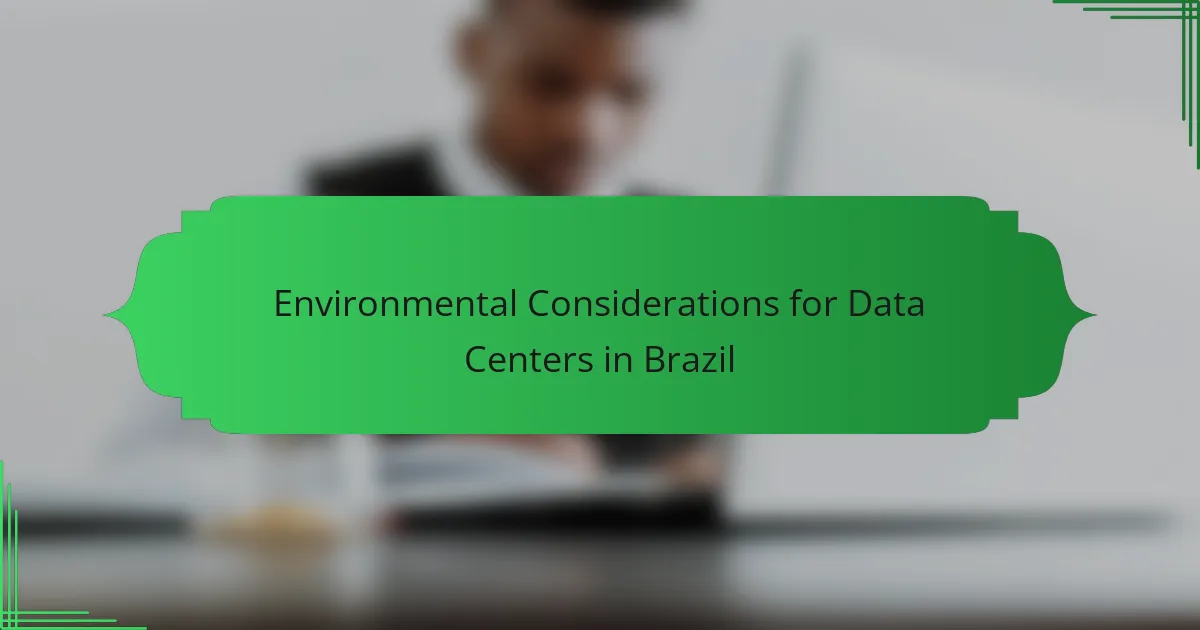Data centers in Brazil play a critical role in the country’s environmental landscape, primarily due to their substantial energy consumption, water usage, and carbon emissions. To foster sustainability, it is essential for these facilities to adopt energy-efficient technologies, utilize renewable energy sources, and implement effective water conservation strategies. By doing so, data centers can not only minimize their ecological footprint but also enhance operational efficiency and reduce costs.

What are the environmental impacts of data centers in Brazil?
Data centers in Brazil significantly impact the environment through their energy consumption, water usage, and carbon emissions. Understanding these aspects is crucial for developing sustainable practices in the industry.
Energy consumption
Data centers are known for their high energy consumption, which can account for a substantial portion of a region’s electricity use. In Brazil, the reliance on both renewable and non-renewable energy sources affects the overall environmental footprint of these facilities.
To mitigate energy consumption, data centers can implement energy-efficient technologies such as advanced cooling systems and server virtualization. Utilizing renewable energy sources, like solar or wind, can also help reduce reliance on fossil fuels and lower operational costs.
Water usage
Water usage in data centers is primarily associated with cooling systems that prevent overheating of servers. In Brazil, where water scarcity can be an issue, optimizing water use is essential for sustainability.
Data centers can adopt water-efficient cooling methods, such as free cooling or closed-loop systems, to minimize water consumption. Regular monitoring and maintenance of these systems can further enhance efficiency and reduce waste.
Carbon emissions
Carbon emissions from data centers stem from the energy consumed during operations, particularly when fossil fuels are used. In Brazil, the carbon footprint of data centers can vary based on the energy mix and efficiency measures implemented.
To lower carbon emissions, data centers should aim to transition to greener energy sources and enhance energy efficiency. Engaging in carbon offset programs can also help mitigate their environmental impact while promoting sustainability initiatives.

How can data centers in Brazil reduce energy consumption?
Data centers in Brazil can significantly reduce energy consumption by adopting energy-efficient technologies, utilizing renewable energy sources, and optimizing their cooling systems. These strategies not only lower operational costs but also contribute to environmental sustainability.
Implementing energy-efficient hardware
Using energy-efficient hardware is crucial for reducing energy consumption in data centers. This includes selecting servers, storage devices, and networking equipment that meet high energy efficiency standards, such as those certified by the Energy Star program.
Additionally, consider upgrading to newer models that offer better performance per watt. For example, modern processors can deliver higher computing power while consuming less energy compared to older generations.
Utilizing renewable energy sources
Incorporating renewable energy sources, such as solar or wind power, can drastically lower the carbon footprint of data centers in Brazil. Many facilities can install solar panels on-site or enter into power purchase agreements (PPAs) with local renewable energy providers.
Brazil has a strong potential for solar energy, especially in the northeastern regions. By investing in renewable energy, data centers can not only reduce their reliance on fossil fuels but also stabilize energy costs over time.
Optimizing cooling systems
Cooling systems account for a significant portion of a data center’s energy use. Optimizing these systems can lead to substantial energy savings. Techniques such as hot aisle/cold aisle containment can improve airflow and reduce the need for excessive cooling.
Implementing advanced cooling technologies, like liquid cooling or evaporative cooling, can also enhance efficiency. Regular maintenance and monitoring of cooling systems ensure they operate at peak efficiency, further minimizing energy consumption.

What are the best practices for water conservation in Brazilian data centers?
Effective water conservation in Brazilian data centers involves implementing strategies such as recycling wastewater, utilizing air cooling technologies, and harvesting rainwater. These practices not only reduce water consumption but also enhance sustainability and operational efficiency.
Recycling wastewater
Recycling wastewater is a crucial practice for data centers aiming to conserve water. This involves treating and reusing water from cooling systems or other processes, significantly reducing the demand for fresh water. Brazilian data centers can adopt technologies like membrane bioreactors or advanced filtration systems to ensure the recycled water meets quality standards.
Implementing a wastewater recycling system can lead to substantial cost savings on water bills and reduce the environmental impact. Data centers should evaluate their wastewater sources and determine the feasibility of treatment options tailored to their specific needs.
Using air cooling technologies
Air cooling technologies are an effective way to minimize water usage in data centers. By utilizing ambient air for cooling instead of water-based systems, facilities can significantly decrease their water consumption. Options include direct and indirect evaporative cooling systems, which can be particularly efficient in Brazil’s varied climate.
Data centers should consider the local climate when selecting air cooling solutions. In regions with high humidity, indirect cooling may be more effective, while drier areas can benefit from direct evaporative cooling. Regular maintenance of these systems is essential to ensure optimal performance and energy efficiency.
Implementing rainwater harvesting
Rainwater harvesting is a sustainable practice that allows data centers to collect and store rainwater for non-potable uses, such as cooling and irrigation. By installing collection systems, facilities can reduce their reliance on municipal water supplies and lower operational costs. In Brazil, where rainfall can be abundant in certain regions, this method can be particularly advantageous.
To implement rainwater harvesting, data centers should assess their roof area and potential catchment systems. Proper filtration and storage solutions are necessary to ensure the collected rainwater is suitable for its intended uses. Additionally, local regulations regarding rainwater use should be reviewed to ensure compliance.

What regulations affect data center sustainability in Brazil?
Data center sustainability in Brazil is influenced by a combination of national environmental laws, state-specific regulations, and international sustainability standards. These regulations aim to minimize environmental impact while promoting energy efficiency and resource conservation.
National environmental laws
Brazil’s national environmental laws set the framework for sustainable practices across various industries, including data centers. Key legislation includes the Environmental Crimes Law, which establishes penalties for environmental damage, and the National Policy on Climate Change, which encourages the reduction of greenhouse gas emissions.
Data centers must comply with licensing requirements from the Brazilian Institute of Environment and Renewable Natural Resources (IBAMA). This includes conducting environmental impact assessments (EIAs) to evaluate potential effects on local ecosystems before construction or expansion.
State-specific regulations
Each Brazilian state may implement additional regulations that affect data center operations. For example, states like São Paulo have stricter energy efficiency standards and require data centers to utilize renewable energy sources to meet sustainability goals.
Local regulations may also dictate water usage and waste management practices, requiring data centers to adopt measures that reduce their environmental footprint. It’s essential for operators to stay informed about these regulations to ensure compliance and avoid penalties.
International sustainability standards
Data centers in Brazil often align with international sustainability standards such as ISO 14001 for environmental management and ISO 50001 for energy management. Adhering to these standards helps facilities improve their operational efficiency and reduce environmental impact.
Additionally, many data centers seek certifications like LEED (Leadership in Energy and Environmental Design) to demonstrate their commitment to sustainable building practices. These certifications can enhance a facility’s reputation and attract clients who prioritize sustainability.

How do data centers in Brazil compare to global sustainability standards?
Data centers in Brazil are increasingly aligning with global sustainability standards, but challenges remain. While some facilities are adopting advanced energy-efficient technologies, many still lag behind in terms of renewable energy usage and waste management practices.
Benchmarking against global leaders
Brazilian data centers can be compared to global leaders by evaluating energy efficiency, carbon emissions, and water usage. For instance, leading data centers in Europe and North America often achieve Power Usage Effectiveness (PUE) ratios below 1.2, while many Brazilian centers are above this threshold. This indicates a need for improvement in operational efficiency.
Additionally, global leaders prioritize the use of renewable energy sources, with some achieving over 80% of their energy from renewables. In contrast, Brazilian data centers still rely heavily on non-renewable sources, although the country’s hydroelectric capacity offers a significant opportunity for improvement.
Adopting best practices from successful models
To enhance sustainability, Brazilian data centers should adopt best practices from successful models worldwide. Implementing advanced cooling technologies, such as liquid cooling or free air cooling, can significantly reduce energy consumption. These methods are already in use in many top-tier facilities globally.
Furthermore, establishing partnerships with local renewable energy providers can facilitate the transition to greener energy sources. Brazilian data centers can also benefit from regular sustainability audits to identify areas for improvement and ensure compliance with international standards.



